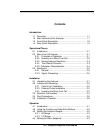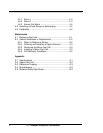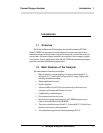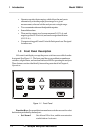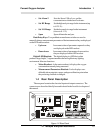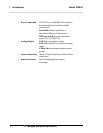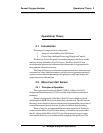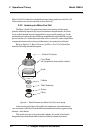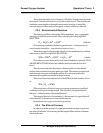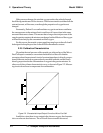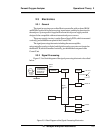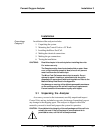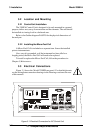
2-1
Percent Oxygen Analyzer Operational Theory 2
Teledyne Analytical Instruments
Operational Theory
2.1 Introduction
The analyzer is composed of two subsystems:
1. Analysis Unit with Micro-Fuel Cell Sensor
2. Control Unit with Signal Processing, Display and Controls
The Analysis Unit is designed to accept the sample gas and direct it to the
sensitive surface of the Micro-Fuel Cell sensor. The Micro-Fuel Cell is an
electrochemical galvanic device that translates the amount of oxygen present in
the sample into an electrical current.
The Control Unit processes the sensor output and translates it into electrical
concentration, range, and alarm outputs, and a percent oxygen meter readout. It
contains a microcontroller that manages all signal processing, input/output, and
display functions for the analyzer.
2.2 Micro-Fuel Cell Sensor
2.2.1 Principles of Operation
The oxygen sensor used in the Model 3300PA is a Micro-Fuel Cell
designed and manufactured by TAI. It is a sealed, disposable electrochemical
transducer.
The active components of the Micro-Fuel Cell are a cathode, an anode,
and the aqueous KOH electrolyte in which they are immersed. The cell converts
the energy from a chemical reaction into an electrical potential that can produce a
current in an external electrical circuit. Its action is similar to that of a battery.
There is, however, an important difference in the operation of a battery as
compared to the Micro-Fuel Cell: In the battery, all reactants are stored within
the cell, whereas in the Micro-Fuel Cell, one of the reactants (oxygen) comes
from outside the device as a constituent of the sample gas being analyzed. The



